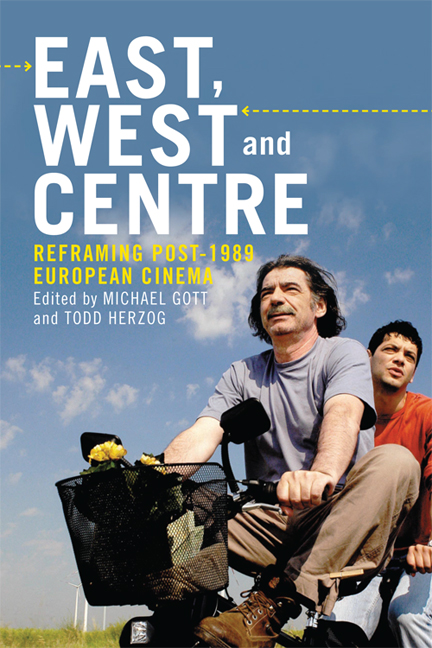Book contents
- Frontmatter
- Contents
- List of Figures
- Notes on Contributors
- Acknowledgements
- Introduction: East, West and Centre: ‘Mapping Post-1989 European Cinema’
- Part I Redrawing the Lines: De/Recentring Europe
- 1 The Berlin Wall Revisited: Reframing Historical Space between East and West in Cynthia Beatts's Cycling the Frame (1988), The Invisible Frame (2009) and Bartosz Konopka's Rabbit à la Berlin (2009)
- 2 Changing Sides: East/West Travesties in Lionel Baier's Comme des voleurs (à l'est)
- 3 Dubbing and Doubling Over: The Disorientation of France in the Films of Michael Haneke and Krzysztof Kieślowski
- 4 Challenging the East–West Divide in Ulrich Seidl's Import Export (2007)
- 5 Fatih Akın's Filmic Visions of a New Europe: Spatial and Aural Constructions of Europe in Im Juli/In July (2000
- 6 Salami Aleikum – The ‘Near East’ Meets the ‘Middle East’ in Europe
- 7 Cinematic Fairy Tales of Female Mobility in Post-Wall Europe: Hanna v. Mona
- Part II Border Spaces, Eastern Margins and Eastern Markets: Belonging and the Road to/from Europe
- Part III Spectres of the East
- Notes
- Bibliography
- Index
4 - Challenging the East–West Divide in Ulrich Seidl's Import Export (2007)
from Part I - Redrawing the Lines: De/Recentring Europe
Published online by Cambridge University Press: 05 September 2016
- Frontmatter
- Contents
- List of Figures
- Notes on Contributors
- Acknowledgements
- Introduction: East, West and Centre: ‘Mapping Post-1989 European Cinema’
- Part I Redrawing the Lines: De/Recentring Europe
- 1 The Berlin Wall Revisited: Reframing Historical Space between East and West in Cynthia Beatts's Cycling the Frame (1988), The Invisible Frame (2009) and Bartosz Konopka's Rabbit à la Berlin (2009)
- 2 Changing Sides: East/West Travesties in Lionel Baier's Comme des voleurs (à l'est)
- 3 Dubbing and Doubling Over: The Disorientation of France in the Films of Michael Haneke and Krzysztof Kieślowski
- 4 Challenging the East–West Divide in Ulrich Seidl's Import Export (2007)
- 5 Fatih Akın's Filmic Visions of a New Europe: Spatial and Aural Constructions of Europe in Im Juli/In July (2000
- 6 Salami Aleikum – The ‘Near East’ Meets the ‘Middle East’ in Europe
- 7 Cinematic Fairy Tales of Female Mobility in Post-Wall Europe: Hanna v. Mona
- Part II Border Spaces, Eastern Margins and Eastern Markets: Belonging and the Road to/from Europe
- Part III Spectres of the East
- Notes
- Bibliography
- Index
Summary
Ulrich Seidl's Import Export (2007, Austria/France/Germany) opens with an older man trying to start an antique motorcycle while standing in a snowy landscape with a white prefabricated slab building in the background. With no apparent road into this field, the scene's blocking, along with its symmetrical framing and the man's direct gaze at the camera, reveal the film's deliberate staging and attempt to awaken our awareness as viewers of this film. Without any geographical context, such as the location intertitles that appear later in the film, the viewer is further invited to draw assumptions about the location on the screen. The Socialist-era style architecture, the older vehicle, the man's fur hat, and the frigid landscape suggest somewhere in Eastern Europe or the former Soviet Union but, devoid of any context, viewers can only assume this by activating preconceptions regarding East and West. This short sequence, indeed, remains extraneous from the film's narratives, sharing with them only the presence of snow. This opening scene encapsulates two aspects that are central to an understanding of Seidl's film: first, the film's critical reflection on the power dynamics inherent to the act of looking – both, in general and as a cinematic self-reflection – and second, the film's challenge to prevailing conceptions of East and West in a post-1989 Europe. After locating Import Export in the context of Austrian cinema and within Seidl's controversial film-making, this chapter will examine key sequences to show how the film visualises the power hierarchies – which here involve East–West relations – that are established through the gaze by calling attention to the act of looking and of being watched. From this reading, it will become clear that the film's narrative conflicts and use of graphic imagery enact a critique of Western perceptions and prejudices that ultimately aims to enable a new way of looking at Eastern Europe and Eastern Europeans.
Looking at Eastern Europe in the Cinema of Ulrich Seidl
A contender for the top prize at Cannes in 2007, Seidl's Import Export is one of the most discussed works of recent Austrian, cinema which has enjoyed a critical renaissance since the 1990s.
- Type
- Chapter
- Information
- East, West and CentreReframing post-1989 European Cinema, pp. 65 - 78Publisher: Edinburgh University PressPrint publication year: 2014



